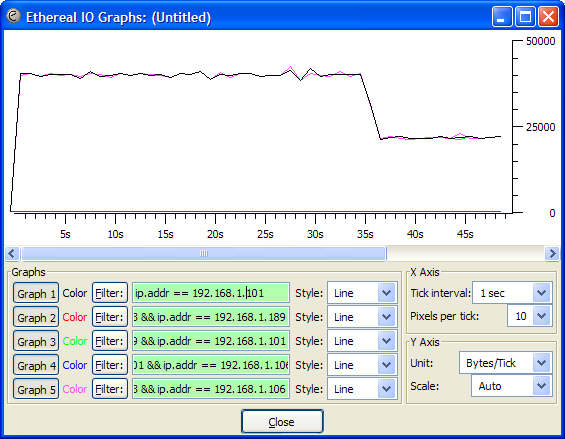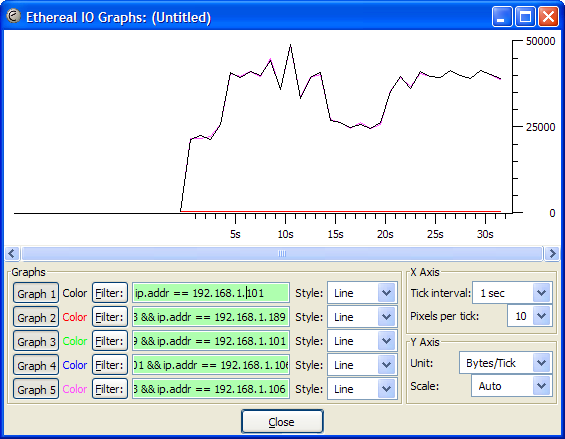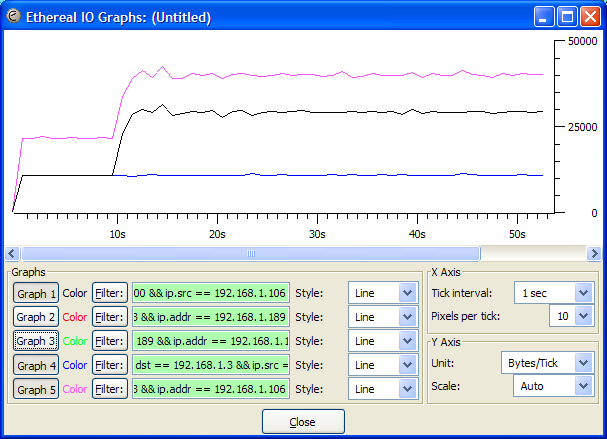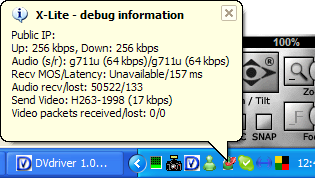Difference between revisions of "Traffic measurements Video"
| Line 53: | Line 53: | ||
* '''Blue''' shows audio-only from ''SIP-phone #2'' to the PBX | * '''Blue''' shows audio-only from ''SIP-phone #2'' to the PBX | ||
* '''Pink''' shows all traffic between ''SIP-phone #1'' and the PBX (both directions) | * '''Pink''' shows all traffic between ''SIP-phone #1'' and the PBX (both directions) | ||
| + | |||
* The debug-screen [[image:X-lite debug-info.png|right|315px|X-lite debug-screen]] of X-lite (Ctrl + F9) told us the SIP-phone assumed a total available bandwith of 256/256 kbps. This was filled with 64 kbps for speech (protocol g711u) and 131 kbps for video (protocol H263-1998). | * The debug-screen [[image:X-lite debug-info.png|right|315px|X-lite debug-screen]] of X-lite (Ctrl + F9) told us the SIP-phone assumed a total available bandwith of 256/256 kbps. This was filled with 64 kbps for speech (protocol g711u) and 131 kbps for video (protocol H263-1998). | ||
Revision as of 17:54, 20 February 2007
Contents
Voice and video analysis
Experimental Setup
In words the configuration is the following: SIP phone #1 is connected to Asterisk #1 and SIP phone #2 is connected to Asterisk #2. The SIP phones are not directly connected to each other but can communicate with each other because Asterisk #1 is directly connected to Asterisk #2 (and vica versa).
Arrows represent possible data traffic that will be measured (see results).
Codec used: ?
Results
In the screenshot below, the following holds:
- @4 sec: Video was turned on
- @14 sec: Video was set to black (connection lost with DVdriver)
- @20 sec: Video showed moving pictures again.
In the screenshot below, the conversation included audio and video until t = 35s. After t = 35s, the traffic is audio-only.

Legenda:
- Black: traffic from and to Trixbox #1
- Red: traffic between the 2 Windows machines running X-lite
- Green: traffic between laptop #1 and its Asterisk
- Blue: traffic between the two Asterisk PBX's
- Pink: traffic between Windows machine #1 and its Asterisk
Conclusions
- First of all, there can be seen from the screenshots shown above that the red line can be represented by (y=0). Because the red line represents the traffic between the 2 Windows machines running X-lite we can conclude that there is no direct traffic between the X-Lites.
- Secondly, there can be seen from the second screenshot that the black, green, blue and pink line represent all the same amount of data traffic. From this there can be concluded that the traffic between the Trixboxes is the same as the triffic to and from the Trixboxes, i.e. the traffic is not limited between the Trixboxes.
- Conclusie over codec gebruikt/wel of niet overeenkomen met verwachte bandwidth usage.
Differences between voice and video
Experimental Setup
Two SIP phones are connected to the same Asterisk PBX Trixbox. One SIP phone is equiped with a camera while the other is not. The bandwidth usage is measured between the Trixbox and the SIP phones connected to it.
Results
Data is collected using WireShark and the data is stored here: (captured Ethereal data)
Legenda:
- Black shows audio & video from SIP-phone #1 to the PBX (video starting at the 10th second)
- Blue shows audio-only from SIP-phone #2 to the PBX
- Pink shows all traffic between SIP-phone #1 and the PBX (both directions)
- The debug-screen of X-lite (Ctrl + F9) told us the SIP-phone assumed a total available bandwith of 256/256 kbps. This was filled with 64 kbps for speech (protocol g711u) and 131 kbps for video (protocol H263-1998).
- When looking at the speech traffic:
- 50 packets/sec (measured with Ethereal)
- 214 Bytes/packet (measured with Ethereal)
- +/- 10,7 kByte/s
- 160 bytes audio-data per packet (64 kbps = 8000 Bytes/sec, 50 packets/sec)
- UDP-packet-header: 28 Bytes.
- Measured IAX-overhead: (the g711u codec uses a CBR of 64kbps) 214 - 28 - 160 = 26 Bytes/packet.
Thus 1300 Bytes/sec IAX overhead (10k4 bps).



